Reviewer's Note: This is a comparison review of two versions of the C6 flashlight model from new manufacturer iTP. Please see their Manufacturer's thread in CPFM. The flashlights were provided by iTP for review.
Warning: Pic heavy!
Part I: Build Overview
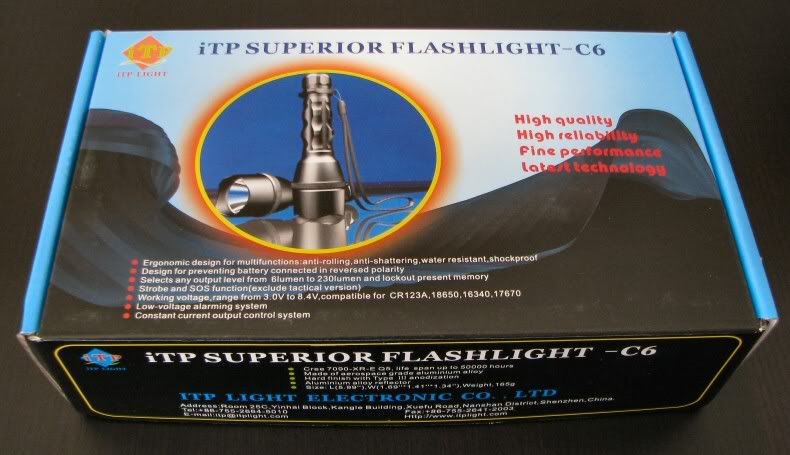
iTP is a new entry into the flashlight business, and the C6 series is their first offering here at CPF. These multi-power lights feature continuously-variable output levels and come in two variants that share basically with the same build - the C6T (Tactical) comes with a forward clicky and lacks the strobe/SOS modes (which are accessed by soft-pressing the reverse clicky on the regular C6 model). A smooth or OP textured reflector is available for either version. For full detailed specs, please check out the box label pics or visit iTP's Manufacturer's thread in CPFM
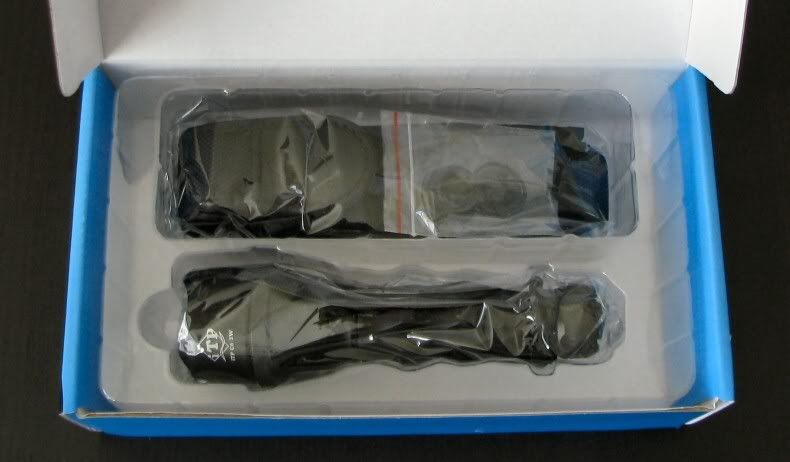
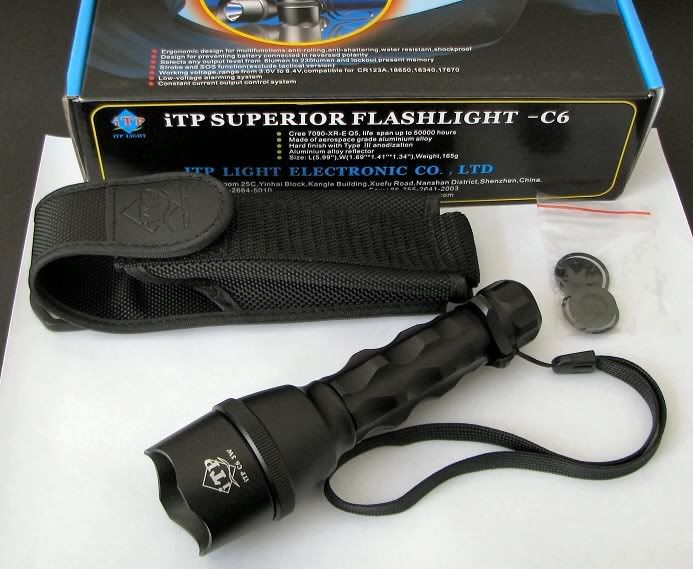
The packaging is identical for the two C6 variants. Inside the box, wrapped in individual plastic pouches, are the light with attached wrist strap, a package of spare o-rings and extra tailcap cover, and a carrying pouch. Quality of the pouch is pretty good, but the quality of the wrist strap is consistent with budget lights. I'd recommend they provide a better one. Instructions for use are on the back of the box:
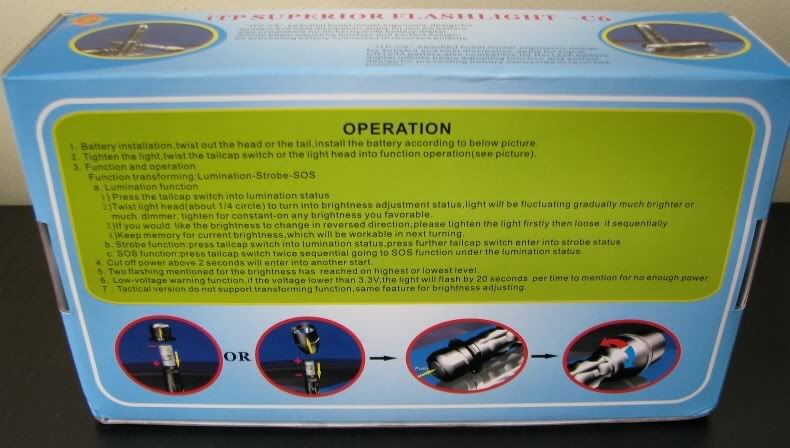
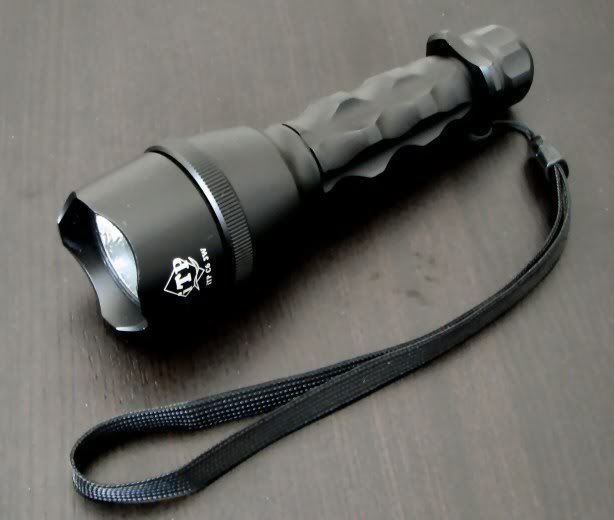
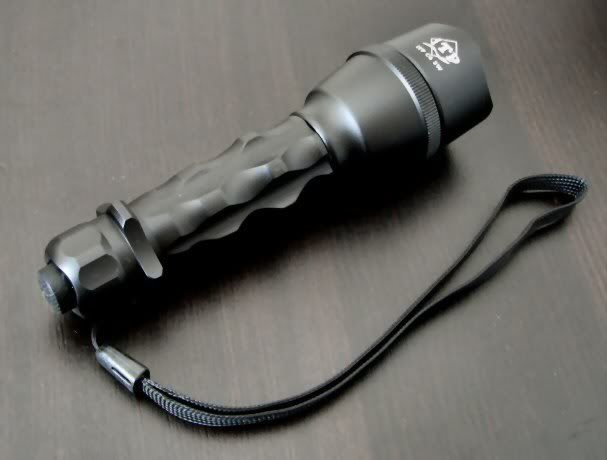
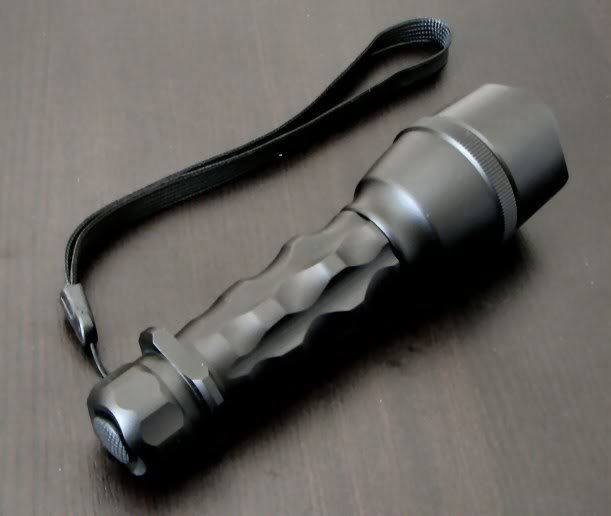
Design is interesting, with the "pineapple" body and tailcap grip ring. Both work well to help improve grip, and the light is well-balanced and comfortable to hold in any format, including cigar-grip fashion. I find the shape of the head to be a little uninspiring, but the texture ring does help for grip (you twist the head to activate the ramp). Both lights come with a scalloped bezel. Fit and finish is good on my samples, with clear lettering and type III hard anodizing (according to the manufacturer).
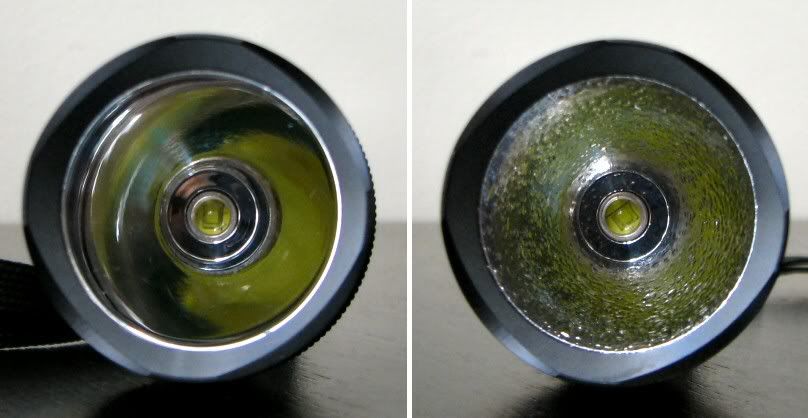
Both lights use a Cree Q5 emitter, and are available with either of the two reflectors shown above. Both of my lights came with the standard "yellow" backed Crees (as opposed to the asian "silver" ones). Texturing on the OP reflector is heavier than on most lights, producing a beam pattern that is virtually devoid of rings. Of course, this also greatly reduces max throw compared to the smooth reflector.
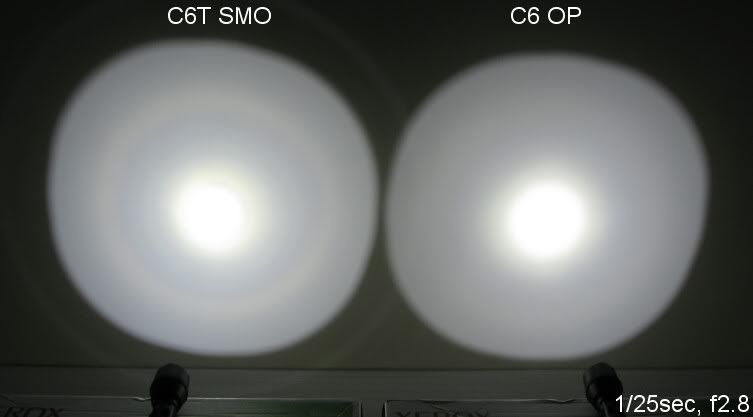
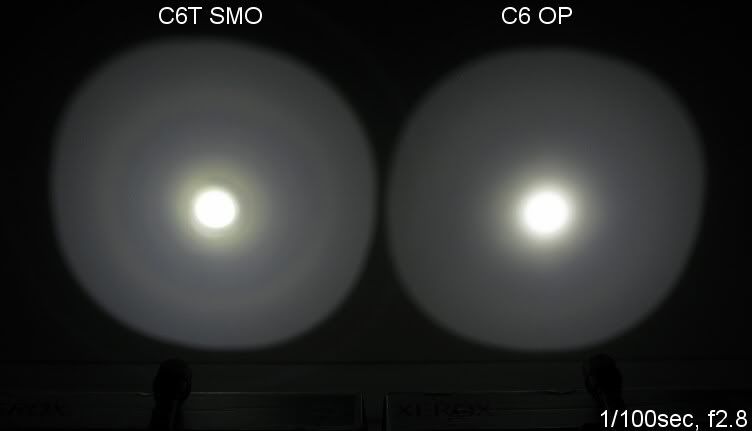
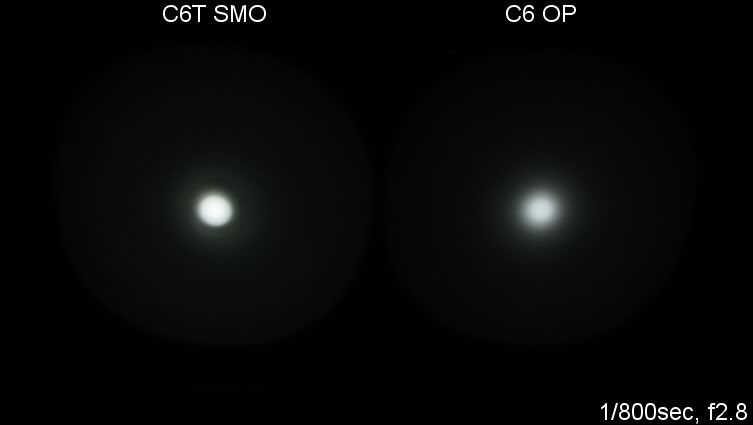
As you can see, spillbeam profile is a little square at close range due to the four-corner scalloping of the bezel (beamshots taken at ~0.5m from a white wall). I'd recommend iTP shorten the bezel to reduce this. Harder to see in the pics, but the smooth reflector is quite ringy (like most throwers). The heavy OP textured reflector produces a very smooth beam profile - it's actually somewhat SSC-like in its beam pattern.
IMO, this is a point in iTP's favour - many vendors sell lightly textured OP reflectors that don't really help with Cree rings, but still reduce throw. If you are going to offer both smooth and textured reflectors, probably best to go with a heavier texture like this one. If you are only going to offer a single reflector, a light OP makes sense to me (i.e. intermediate solution). Just my $0.02.
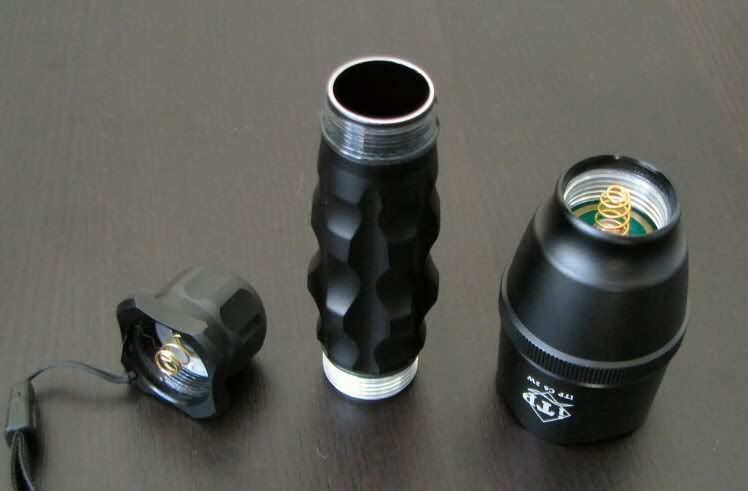
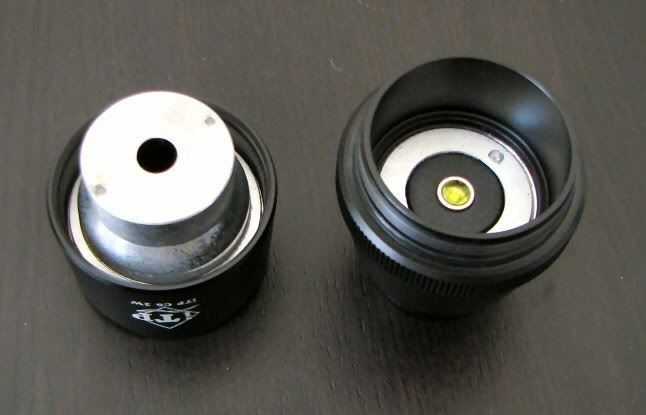
Overall build quality of the light seems quite good. Weight is a respectable 154g. Reflector and emitter assembly are easily accessible. Body tube comes with anodized tailcap threads, so tailcap lock-out is available on both models. :thumbsup:
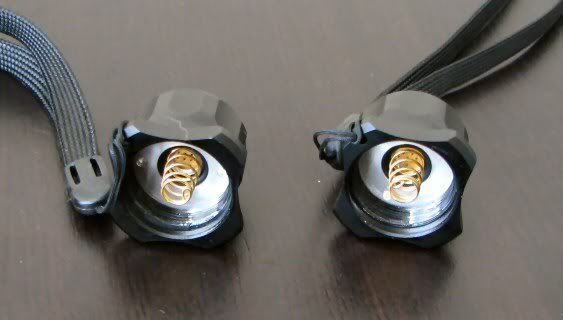
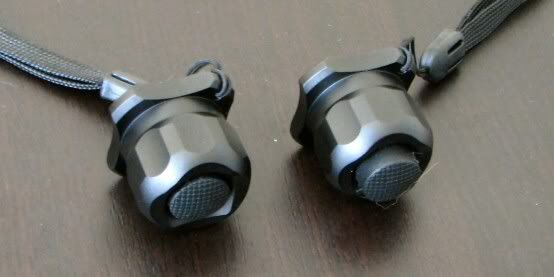
Tailcaps are pretty much identical except for the greatly protruding forward clicky on the C6T (Tactical) version. Both switches have good tactile feel, and are easy to access. Note that tailcap cover on the regular reverse-clicky C6 version protrudes slightly, preventing tailstanding (the forward clicky certainly can't tailstand).
Features and User Interface
User interface is interesting. As mentioned before, the difference between the two lights is that the C6T (Tactical) comes with a forward clicky and lacks the strobe/SOS modes (which are accessed by soft-pressing the reverse clicky on the regular C6 model). Both lights share the same continuously-variable ramping mechanism (scroll down to Part II to see a time comparison of the C6 ramp to other lights).
The UI is straight-forward - turn the light on/off by pressing the tailcap clicky (press for momentary-on in the tactical version, press and click for sustained on in both).
To activate the ramp, simply loosen the head slightly. This immediately starts the output ramping (to reverse the direction of the ramp, tighten and loosen again). When the light reaches the level you like, simply tighten the head to memorize that setting. This is actually quite a smart design, very intuitive. There's no need to perform a rapid "switch" within a narrow time-window, and you don't need to turn the light off to save the setting (i.e. as in the original NiteCore offerings). Simply loosen to ramp, tighten to save the setting. The light flashes 3 times briefly to let you know when you have reached the min or max of the ramp.
On the regular version, soft-press the clicky (or click off/on quickly) to advance to strobe and then SOS modes. Strobe is set to 9.6Hz on my sample. Note that both strobe and SOS are always set at max brightness - the ramp doesn't work in these modes.
The lights uses PWM for low modes, and the frequency is high enough so that I was unable to detect it by eye or my setup. The output/runtime efficiency is also surprisingly good for this circuit - scroll down to my runtime comparisons for more info.
One minor quibble - on turning on my reverse-clicky C6, I notice there's a brief flash of low output before the light jumps to whatever output level you have set it at. Sort of the opposite of the high output flash that some Fenix models use to have. Just an observation - note my C6T doesn't show this behaviour. Not a big deal to me.
Note also that the light comes with reverse polarity protection. I've tested it, and it seems to work well. :thumbsup:
Part II: Comparison Review
For comparisons, I've chosen (from left to right): the iTP C6, iTP C6T, JetBeam Jet-III PRO IBS, Romisen RC-M4 P-60 host (with DealExtreme sku.11074 continuously-variable drop-in), Regalight WT-1, Dereelight DBS V2 with continuously-variably DI pill (not shown), and the Fenix T1 (not shown).
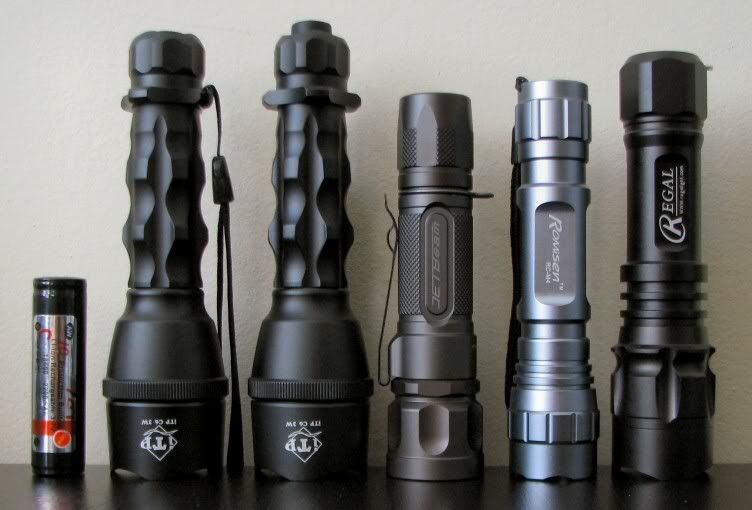
The most obvious comparisons are to the continuously-variable competition (i.e. Jet-III PRO IBS, DBS DI-pill, DX sku.11074 drop-in for P-60 hosts). However, unlike those lights, the iTP C6 has a multi-power circuit that allows you to run 2xCR123A and 2xRCR in addition to 1x18650 (the other 3 lights are all 18650-only). The Regal WT1 is a multi-power light, but uses a resistor for its low mode (not variable). And the Fenix T1 is a two-mode only light that is current-controlled for its low mode and doesn't take single Li-ions. Keep those caveats in mind as we compare apples-to-oranges here ...
Weights:
iTP C6/C6T: 154g
Jet-III PRO IBS: 107g
Romisen RC-M4: 87g
Regal WT1: 134g
DBS V2: 194g
Comparison Beamshots
All lights are on max/100% on 18650 (AW Protected), about 0.5 meters from a white wall.
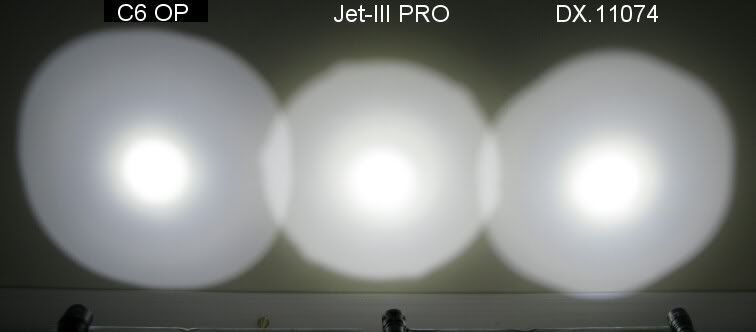
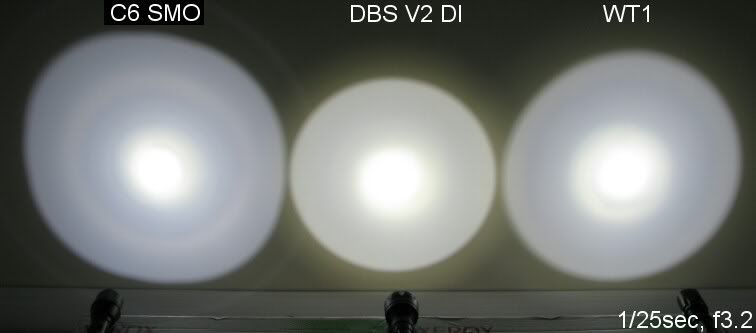
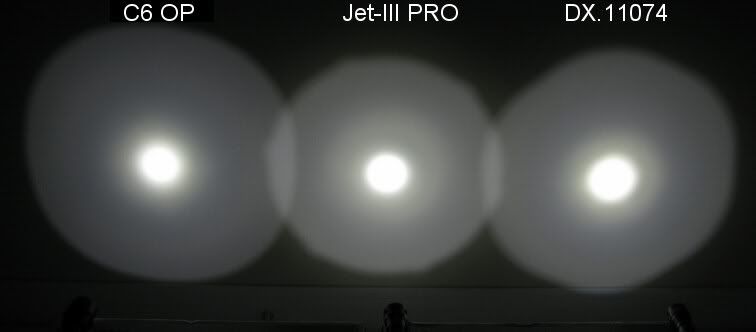
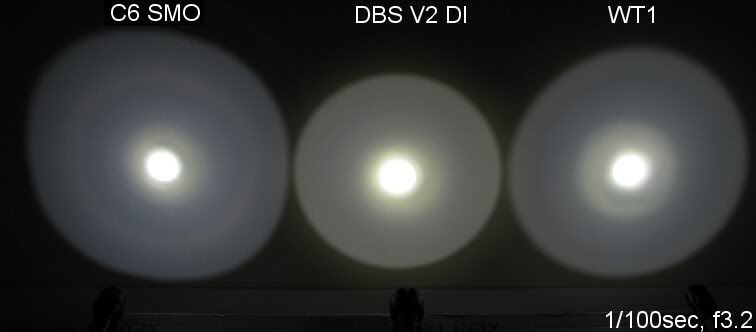
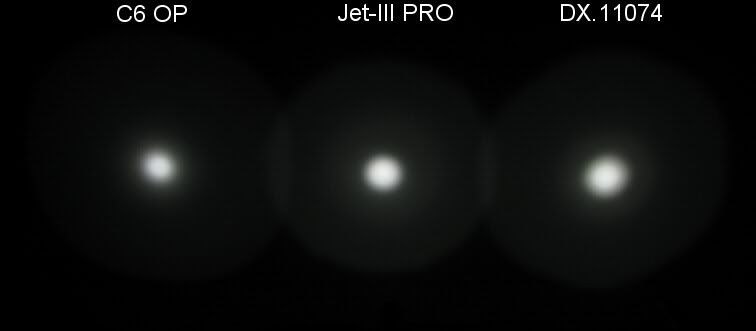
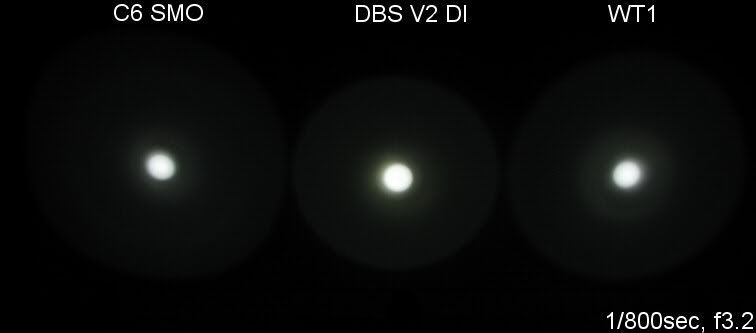
Testing Method: All my output numbers are relative for my home-made light box setup, a la Quickbeam's flashlightreviews.com method. You can directly compare all my relative output values from different reviews - i.e. an output value of "10" in one graph is the same as "10" in another. All runtimes are done under a cooling fan, except for the extended run Lo/Min modes which are done without cooling.
Throw values are the square-root of lux measurements taken at 1 meter from the lens, using a light meter.
Throw/Output Summary Chart:
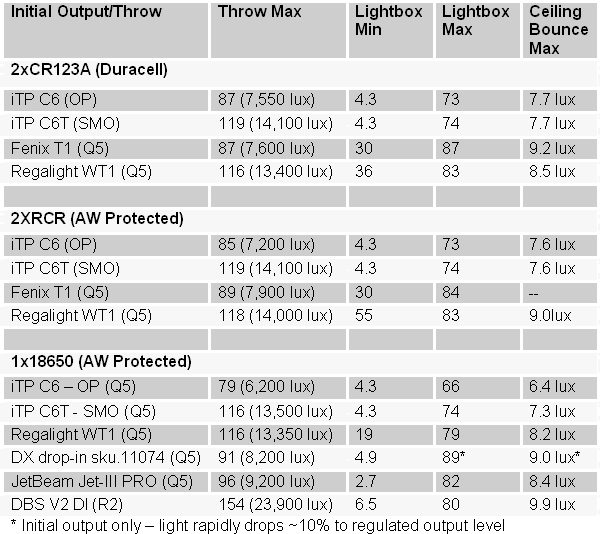
As you can see, the overall characteristics of the C6s are pretty similar to their other continuously-variable competition (Jet-III, DBS DI-pill, DX sku.11074 drop-in for P-60 hosts). Max throw is roughly comparable to the Regal WT1, with both using smooth reflectors. The OP textured reflector for the C6 greatly reduces throw.
Variable Output Ramping
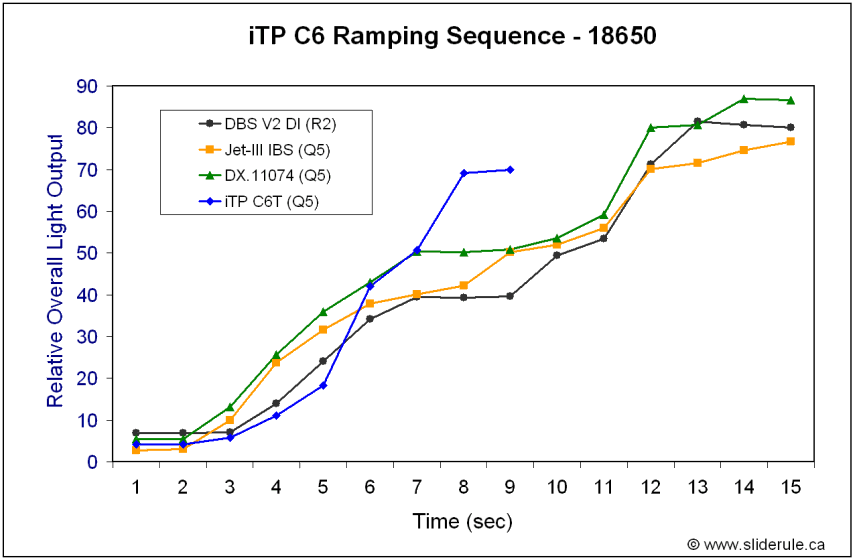
As you can see, the C6 ramp is relatively linear and faster than most of the competition. The light flashes 3 times rapidly to let you know when it has reached the end of its ramp (either min or max).
Output/Runtime Comparison:
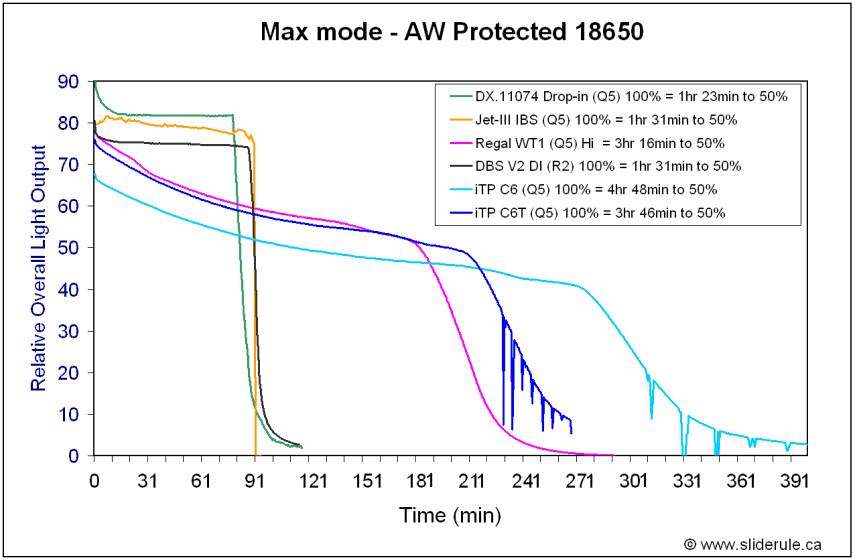
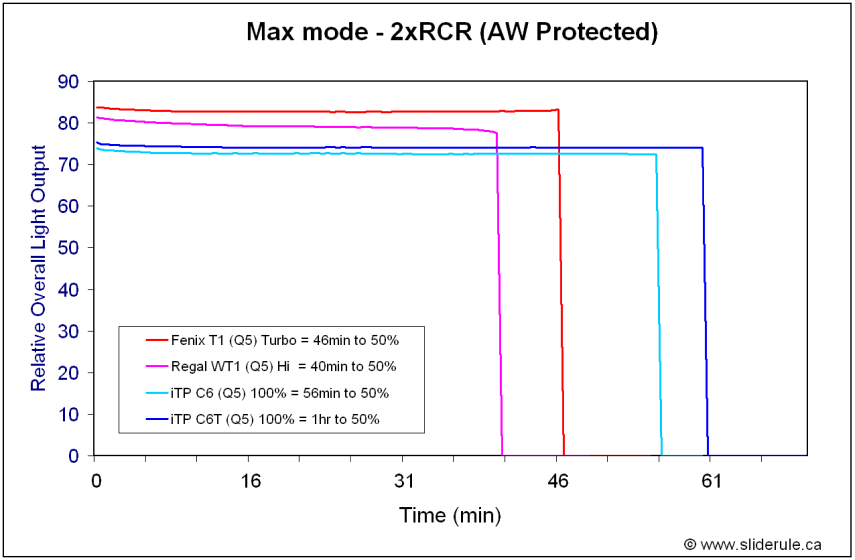
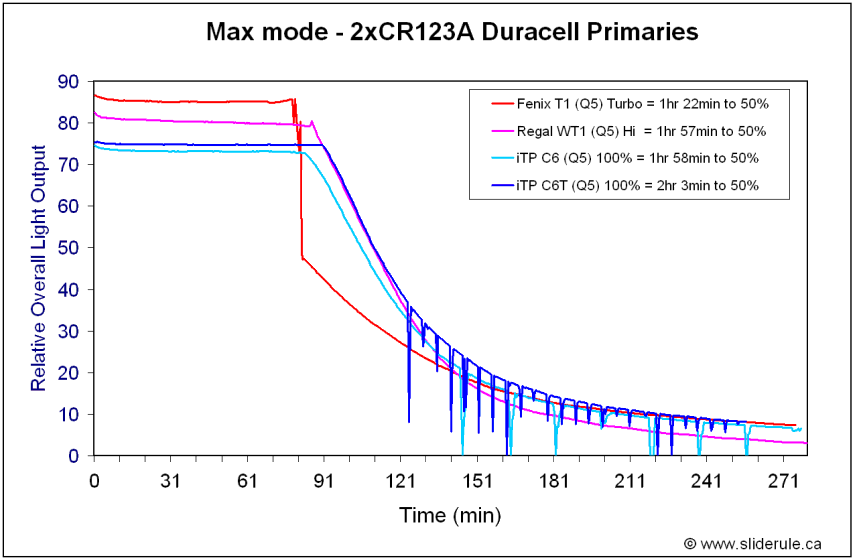
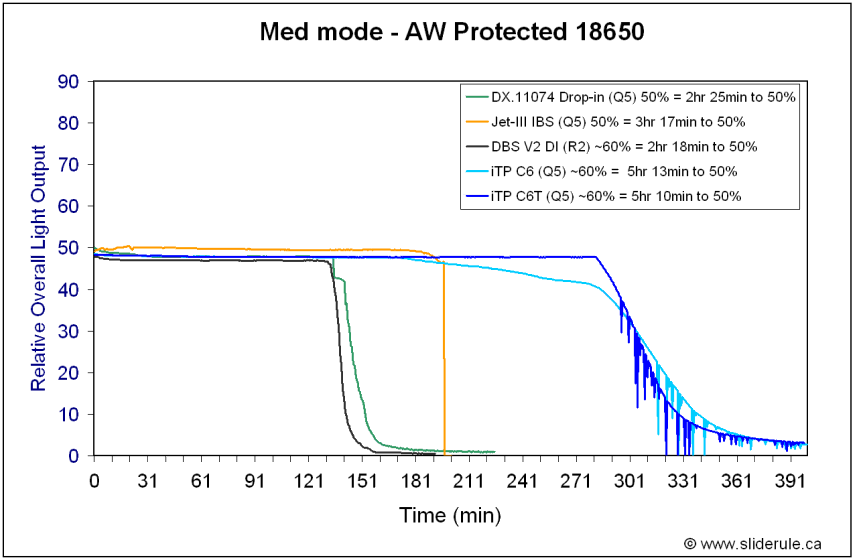
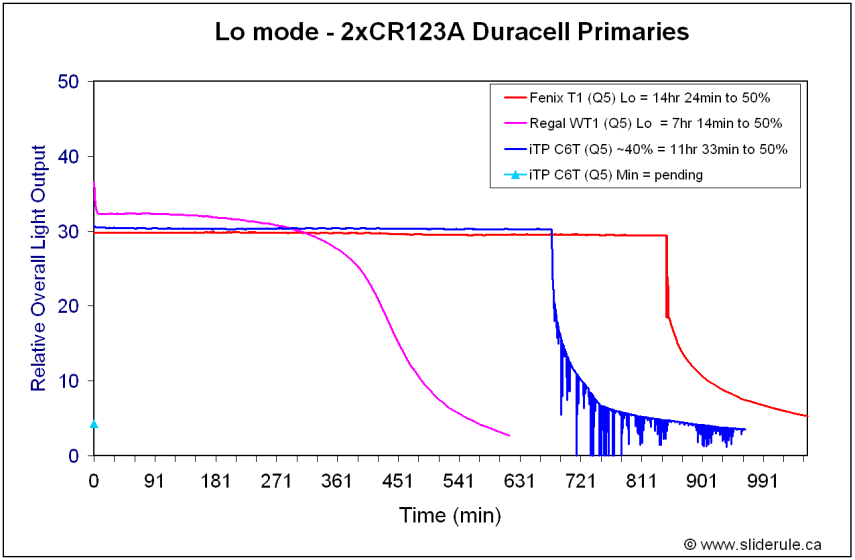
Output/Runtime Pattern:
If you just looked at the Max output runs, you might be disappointed to see the standard direct-drive pattern of the C6s on 18650. But first appearances can be deceiving in this case. A few points to keep in mind:
Personally, I was pretty blown away by the Medium runtime test on 18650. As you can see, the 18650-only DX 11074 drop-in has roughly equivalent output/runtime as the DBS DI pill (also 18650-only). The JetBeam IBS circuit (which has a higher burden since it also has to support lower voltage standard alkaline/NiMH batteries in the Jet-I/II format) pulls ahead with a significant increase in runtime. But the C6s just blows right past even the IBS! Frankly, this is remarkable performance for a multi-power setup that can also handle 2xCR123A and 2xRCR in fully-regulated fashion. :twothumbs
Frankly, this is remarkable performance for a multi-power setup that can also handle 2xCR123A and 2xRCR in fully-regulated fashion. :twothumbs
On primaries, the C6s don't do quite as well as the current-controlled low mode of the Fenix T1, but that's hardly surprising in PWM-based lights like the C6s. And again, keep in mind the T1 only has a single defined low mode (and isn't compatible with single Li-ions). Unfortunately, I don't have the newer multi-power TK10 or TK11 to compare.
Part III: Preliminary Discussion
General Observations
The C6s are the first offerings by iTP here on CPF, and they have a lot going for them. These are actually the first lights with continuously-variable circuits that I've tested that also feature regulated multi-power compatibility.
Build is interesting. I personally like the "pineapple" body design and built-in grip ring. Option for both smooth and textured reflectors, and both forward and reverse clickies (albeit with strobe/SOS feature only with the reverse clicky) adds to versatility. The textured reflector does a great job of reducing rings, but at the expense of throw. Anodized tailcap threads are also a plus. :kiss:
But there are some minor tweaks that would make these lights even better (e.g. tailstanding in the reverse clicky model, shortened bezel to reduce square beam effect, better wrist lanyard, etc.). Personal preference again, but I find the head of the unit looks fairly plain in comparison to the stylish and functional battery tube/tailcap. At the end of the day, build quality is definitely better than any of the inexpensive DX/Kai lights, through not quite up to the standard of some of the more established (and expensive) makers here. But they definitely seem like good value for the money.
User interface is good IMO - very simple and straight-forward. No need for multiple clicks or twist switches in short periods of time. Just loosen to ramp, tighten to save. Can't get much simpler than that.
But the most impressive thing for me is the output/runtime pattern. Although some may decry the direct-drive characteristics of these lights on max on 18650, this actually has some significant advantages at lower output levels. Simply put, output/runtime efficiency on 18650 is better than any of the other continuously-variable 18650-only lights tested here.
You also get a long "moon mode" of reduced output on 18650 before the protection circuit kicks in (although with the low voltage flash during most of this low-mode time). I let it run for ~12 hours on one test, and it was still producing light without triggering the protection circuit. Oh, and did I mention they are multi-power circuits that take 2xCR123A and 2xRCR in a regulated fashion?
As you can probably tell, I'm quite impressed for a first offering. With some tweaks and thoughtful built improvements, I expect these lights will be serious contenders here.
Warning: Pic heavy!
Part I: Build Overview

iTP is a new entry into the flashlight business, and the C6 series is their first offering here at CPF. These multi-power lights feature continuously-variable output levels and come in two variants that share basically with the same build - the C6T (Tactical) comes with a forward clicky and lacks the strobe/SOS modes (which are accessed by soft-pressing the reverse clicky on the regular C6 model). A smooth or OP textured reflector is available for either version. For full detailed specs, please check out the box label pics or visit iTP's Manufacturer's thread in CPFM


The packaging is identical for the two C6 variants. Inside the box, wrapped in individual plastic pouches, are the light with attached wrist strap, a package of spare o-rings and extra tailcap cover, and a carrying pouch. Quality of the pouch is pretty good, but the quality of the wrist strap is consistent with budget lights. I'd recommend they provide a better one. Instructions for use are on the back of the box:




Design is interesting, with the "pineapple" body and tailcap grip ring. Both work well to help improve grip, and the light is well-balanced and comfortable to hold in any format, including cigar-grip fashion. I find the shape of the head to be a little uninspiring, but the texture ring does help for grip (you twist the head to activate the ramp). Both lights come with a scalloped bezel. Fit and finish is good on my samples, with clear lettering and type III hard anodizing (according to the manufacturer).

Both lights use a Cree Q5 emitter, and are available with either of the two reflectors shown above. Both of my lights came with the standard "yellow" backed Crees (as opposed to the asian "silver" ones). Texturing on the OP reflector is heavier than on most lights, producing a beam pattern that is virtually devoid of rings. Of course, this also greatly reduces max throw compared to the smooth reflector.



As you can see, spillbeam profile is a little square at close range due to the four-corner scalloping of the bezel (beamshots taken at ~0.5m from a white wall). I'd recommend iTP shorten the bezel to reduce this. Harder to see in the pics, but the smooth reflector is quite ringy (like most throwers). The heavy OP textured reflector produces a very smooth beam profile - it's actually somewhat SSC-like in its beam pattern.
IMO, this is a point in iTP's favour - many vendors sell lightly textured OP reflectors that don't really help with Cree rings, but still reduce throw. If you are going to offer both smooth and textured reflectors, probably best to go with a heavier texture like this one. If you are only going to offer a single reflector, a light OP makes sense to me (i.e. intermediate solution). Just my $0.02.


Overall build quality of the light seems quite good. Weight is a respectable 154g. Reflector and emitter assembly are easily accessible. Body tube comes with anodized tailcap threads, so tailcap lock-out is available on both models. :thumbsup:


Tailcaps are pretty much identical except for the greatly protruding forward clicky on the C6T (Tactical) version. Both switches have good tactile feel, and are easy to access. Note that tailcap cover on the regular reverse-clicky C6 version protrudes slightly, preventing tailstanding (the forward clicky certainly can't tailstand).
Features and User Interface
User interface is interesting. As mentioned before, the difference between the two lights is that the C6T (Tactical) comes with a forward clicky and lacks the strobe/SOS modes (which are accessed by soft-pressing the reverse clicky on the regular C6 model). Both lights share the same continuously-variable ramping mechanism (scroll down to Part II to see a time comparison of the C6 ramp to other lights).
The UI is straight-forward - turn the light on/off by pressing the tailcap clicky (press for momentary-on in the tactical version, press and click for sustained on in both).
To activate the ramp, simply loosen the head slightly. This immediately starts the output ramping (to reverse the direction of the ramp, tighten and loosen again). When the light reaches the level you like, simply tighten the head to memorize that setting. This is actually quite a smart design, very intuitive. There's no need to perform a rapid "switch" within a narrow time-window, and you don't need to turn the light off to save the setting (i.e. as in the original NiteCore offerings). Simply loosen to ramp, tighten to save the setting. The light flashes 3 times briefly to let you know when you have reached the min or max of the ramp.
On the regular version, soft-press the clicky (or click off/on quickly) to advance to strobe and then SOS modes. Strobe is set to 9.6Hz on my sample. Note that both strobe and SOS are always set at max brightness - the ramp doesn't work in these modes.
The lights uses PWM for low modes, and the frequency is high enough so that I was unable to detect it by eye or my setup. The output/runtime efficiency is also surprisingly good for this circuit - scroll down to my runtime comparisons for more info.
One minor quibble - on turning on my reverse-clicky C6, I notice there's a brief flash of low output before the light jumps to whatever output level you have set it at. Sort of the opposite of the high output flash that some Fenix models use to have. Just an observation - note my C6T doesn't show this behaviour. Not a big deal to me.
Note also that the light comes with reverse polarity protection. I've tested it, and it seems to work well. :thumbsup:
Part II: Comparison Review
For comparisons, I've chosen (from left to right): the iTP C6, iTP C6T, JetBeam Jet-III PRO IBS, Romisen RC-M4 P-60 host (with DealExtreme sku.11074 continuously-variable drop-in), Regalight WT-1, Dereelight DBS V2 with continuously-variably DI pill (not shown), and the Fenix T1 (not shown).

The most obvious comparisons are to the continuously-variable competition (i.e. Jet-III PRO IBS, DBS DI-pill, DX sku.11074 drop-in for P-60 hosts). However, unlike those lights, the iTP C6 has a multi-power circuit that allows you to run 2xCR123A and 2xRCR in addition to 1x18650 (the other 3 lights are all 18650-only). The Regal WT1 is a multi-power light, but uses a resistor for its low mode (not variable). And the Fenix T1 is a two-mode only light that is current-controlled for its low mode and doesn't take single Li-ions. Keep those caveats in mind as we compare apples-to-oranges here ...
Weights:
iTP C6/C6T: 154g
Jet-III PRO IBS: 107g
Romisen RC-M4: 87g
Regal WT1: 134g
DBS V2: 194g
Comparison Beamshots
All lights are on max/100% on 18650 (AW Protected), about 0.5 meters from a white wall.






Testing Method: All my output numbers are relative for my home-made light box setup, a la Quickbeam's flashlightreviews.com method. You can directly compare all my relative output values from different reviews - i.e. an output value of "10" in one graph is the same as "10" in another. All runtimes are done under a cooling fan, except for the extended run Lo/Min modes which are done without cooling.
Throw values are the square-root of lux measurements taken at 1 meter from the lens, using a light meter.
Throw/Output Summary Chart:

As you can see, the overall characteristics of the C6s are pretty similar to their other continuously-variable competition (Jet-III, DBS DI-pill, DX sku.11074 drop-in for P-60 hosts). Max throw is roughly comparable to the Regal WT1, with both using smooth reflectors. The OP textured reflector for the C6 greatly reduces throw.
Variable Output Ramping

As you can see, the C6 ramp is relatively linear and faster than most of the competition. The light flashes 3 times rapidly to let you know when it has reached the end of its ramp (either min or max).
Output/Runtime Comparison:





Output/Runtime Pattern:
If you just looked at the Max output runs, you might be disappointed to see the standard direct-drive pattern of the C6s on 18650. But first appearances can be deceiving in this case. A few points to keep in mind:
- Unlike the continuously-variable competition, the iTP lights are multi-power and fully regulated on 2xCR123A and 2xRCR.
- The C6 is regulated at lower output modes on 18650 - until the battery is nearly exhausted and then it drops out of regulation. An advantage to this pattern is that you don't suddenly hit the battery protection circuit without warning - you have a long period of declining low output light first.
- C6 lights feature a low voltage warning flash (i.e. all the spiky noise at the ends of the traces). This is a rapid triple flash of the light (similar to the max and min flash at the ends of the ramp). It occurs at a freq of ~6 secs once the low voltage trigger is reached. Personally, I find this a bit superfluous, since the lower output tells you that you are out of regulation and thus nearing the end of useful battery life.
- Max output seems a little lower than some of the lights tested here, but with corresponding longer runtime. The max output/runtime variation between my two samples likely just reflects Vf differences between the emitters (which would be expected to have a significant impact when direct-driven).
Personally, I was pretty blown away by the Medium runtime test on 18650. As you can see, the 18650-only DX 11074 drop-in has roughly equivalent output/runtime as the DBS DI pill (also 18650-only). The JetBeam IBS circuit (which has a higher burden since it also has to support lower voltage standard alkaline/NiMH batteries in the Jet-I/II format) pulls ahead with a significant increase in runtime. But the C6s just blows right past even the IBS!
 Frankly, this is remarkable performance for a multi-power setup that can also handle 2xCR123A and 2xRCR in fully-regulated fashion. :twothumbs
Frankly, this is remarkable performance for a multi-power setup that can also handle 2xCR123A and 2xRCR in fully-regulated fashion. :twothumbsOn primaries, the C6s don't do quite as well as the current-controlled low mode of the Fenix T1, but that's hardly surprising in PWM-based lights like the C6s. And again, keep in mind the T1 only has a single defined low mode (and isn't compatible with single Li-ions). Unfortunately, I don't have the newer multi-power TK10 or TK11 to compare.
Part III: Preliminary Discussion
General Observations
The C6s are the first offerings by iTP here on CPF, and they have a lot going for them. These are actually the first lights with continuously-variable circuits that I've tested that also feature regulated multi-power compatibility.
Build is interesting. I personally like the "pineapple" body design and built-in grip ring. Option for both smooth and textured reflectors, and both forward and reverse clickies (albeit with strobe/SOS feature only with the reverse clicky) adds to versatility. The textured reflector does a great job of reducing rings, but at the expense of throw. Anodized tailcap threads are also a plus. :kiss:
But there are some minor tweaks that would make these lights even better (e.g. tailstanding in the reverse clicky model, shortened bezel to reduce square beam effect, better wrist lanyard, etc.). Personal preference again, but I find the head of the unit looks fairly plain in comparison to the stylish and functional battery tube/tailcap. At the end of the day, build quality is definitely better than any of the inexpensive DX/Kai lights, through not quite up to the standard of some of the more established (and expensive) makers here. But they definitely seem like good value for the money.
User interface is good IMO - very simple and straight-forward. No need for multiple clicks or twist switches in short periods of time. Just loosen to ramp, tighten to save. Can't get much simpler than that.
But the most impressive thing for me is the output/runtime pattern. Although some may decry the direct-drive characteristics of these lights on max on 18650, this actually has some significant advantages at lower output levels. Simply put, output/runtime efficiency on 18650 is better than any of the other continuously-variable 18650-only lights tested here.

You also get a long "moon mode" of reduced output on 18650 before the protection circuit kicks in (although with the low voltage flash during most of this low-mode time). I let it run for ~12 hours on one test, and it was still producing light without triggering the protection circuit. Oh, and did I mention they are multi-power circuits that take 2xCR123A and 2xRCR in a regulated fashion?
As you can probably tell, I'm quite impressed for a first offering. With some tweaks and thoughtful built improvements, I expect these lights will be serious contenders here.
Last edited:


 All of which is another reason why I don't find the low voltage warning flash very useful, since you might want to take advantage of this low mode.
All of which is another reason why I don't find the low voltage warning flash very useful, since you might want to take advantage of this low mode.
